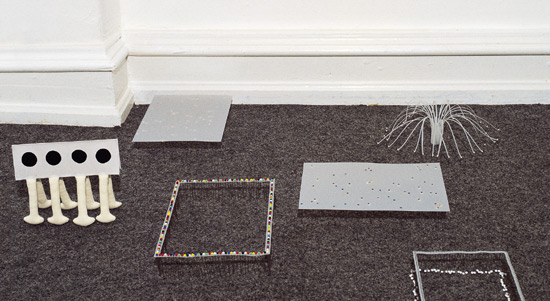
FRINGES AND BRISTLES
Kunstverein Wolfenbüttel, 2001
BECOMING
There are the normal black plastic buckets that rest on white multi-limbed tentacle-like tubes with which they might at any time remove themselves from the exhibition space with strange rhythms of locomotion. There are these flat objects, sometimes round, sometimes longish with rounded edges, that stand on black bristles and, when looked at in a row, demarcate something like a cartographic borderline in the room. But it, too, seems to be en route, could move its delicate little feet at any time and thus make the function as a borderline absurd. And there are objects made of foil which are already on the move, moving through contracting and stretching like caterpillars, again supported by bristles or pins with coloured heads. All this we view from above, from the perspective of the 'point' in Wilhelm Busch's Edward's Dream or of the aeronaut Gianozzo in the novella by Jean Paul. For both authors, the earth, viewed from high up in the air, is teeming area, poetically teeming, a theatre of the world in miniature, in which we are, in spite of the distance, allowed to play a role through the imagination.
So it can happen that the aeronaut Giannozzo sees into the depths of the sea from high up in the clouds: 'The earth was to me now a seabed full of monstrous sea animals, where with my diving bell I did not want to go, even though I had to buy new furniture.' And it seems similar with the floor sculptures by Isabel Schmiga. Our lofty position, being above things, makes the floor of the gallery seem like the ground of the sea, cartography, or a moving landscape. Nothing is fixed here, everything is open for the 'space for thinking'.
It continues differently on the walls. Again bristles, pins, and transparencies, which however now are conceived with a direct gaze in mind. We must approach the reliefs, hanging sculptures, and drawings as if with a magnifying glass, and yet we must also have an eye for the composition of the entire space. Because all these things Isabel Schmiga attaches to these walls stand in a relation both to the room and to each other. Present untidinesses of the room are carefully, delicately taken up by the artist thematically, and thus emphasised. Invisible contact lines go through the room of presentation in order to be representative.
That which is sown, folded, glued, punctured, pierced, or lined by dashes and threads, moves these subtle objects of attention. They force us to come close, because otherwise we don't see anything, guess nothing of their structure and their specific spirit. In Isabel Schmiga's Kunstkammer of the imagination, a world is spread before us that is unfamiliar and yet reminds us of scientific experiments, of a precise clarity behind which lies a secret meaning. They are objects of an 'artful science' (Barbara Maria Stafford) that display their meticulous results, without however giving us a key to their interpretation.
We examine above all rows of the minute, which permeate as difference in repetition, or as overlaps, palimpsests, which transparently have themselves as their object. That turns the objects, in spite of their small size, into autonomous objects, into subjects of contemplation.
It is a function of the minute to refer to itself the more it is in danger of disappearing. If we assume, in accordance with old and new theory, that the microcosm contains the world, smallness clarifies a dimension of knowledge on a perspectival basis which gives thinking its space. While we are impressed by size, the minute has to draw attention to itself to become large. But by having to exert itself in that way, it is more elaborate than that which is large. It 'becomes', it 'is' not already. It intensifies the act of beholding and has a tendency, as Gilles Deleuze and Felix Guattari show using the example of Franz Kafka, to proliferate.
The objects on the wall and on the floor are not only in themselves tied, bur also tied to each other, an art that can only exist in miniature. Therefore, hierarchies are precluded. They are democratic, even anarchic. They coexist without denying each other their peculiar freedom.
A small object always seeks out another for endorsement, to advance deterritorialisation. Since it is rhythmatised in itself, it infects us through the richness of its movement of 'becoming'. It can, and that is its power, 'become' comic, serious, ambiguous, one-sided, morphological, functional, cheerful, or melancholic. It can openly show craftsmanship and virtuosity, or hide in the shell of obstinacy.
These are the relations that Isabel Schmiga brings to life and which 'become' productive because they insist on the subtle and moving irrepressibility of the small form.
MICHAEL GLASMEIER
Professor of history of art at Hochschule für Künste Bremen
Wilhelm Busch, 'Eduards Traum', Gesammelte Werke in sechs Bänden, Herrsching 1978 · Jonathan Crary, Techniques of the Observer: On Vision and Modernity in the 19th Century, Cambridge, MA, October Books, 1990 · Gilles Deleuze, Difference and Repetition, transl. Paul Patton, New York, Columbia UP, 1995 · Gilles Deleuze, Felix Guattari, Kafka: Towards a Minor Literature, Minneaplis, transl. Dana Polan, University of Minnesota Press, 1986 1976 · Gabriele Dürbeck u.a. (Hg.), Wahrnehmung der Natur - Natur der Wahrnehmung. Studien zur Geschichte visueller Kultur um 1800, Dresden 2001 · Jean Paul, 'Titan, in: Sämtliche Werke, Frankfurt am Main 1996 · Barbara Maria Stafford, Artful Science: Enlightenment Entertainment and the Eclipse of Visual Education, Cambridge, MA, MIT Press, 1996 · Edgar Wind, Experiment and metaphysics: Toward a Resolution of the Cosmologican Antinomies, transl. Cyril Edwards, Oxford, Legenda 2002.